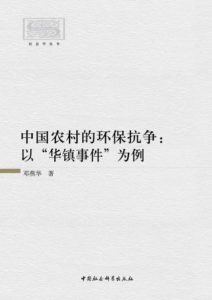
Deng Yanhua 邓燕华
Beijing: Social Sciences Academic Press 中国社会科学出版社 (2016)
Reviewed by Shen Yang (City University of Hong Kong; HYI Visiting Fellow, Chinese Politics Training Program, 2018-19)
Deng Yanhua’s book Environmental Resistance in Rural China: the Case of Huazhen was originally developed from her PhD dissertation, which is one of the most successful theses in terms of publication record. Based on the dissertation, Deng published several articles in top China Studies journals and now offers this book as a comprehensive analysis for the case of environmental contention in Huazhen. Potential readers now not only have access to the rich details of the protest—made available by Deng’s impressive fieldwork—but also useful insights into the process of how the author developed her dissertation into numerous articles and a successful book project. Undoubtedly, this book is of definite value to both graduate students and junior scholars.
The book studies how the villagers in Huazhen, Zhejiang Province, managed to succeed in a 2005 environmental dispute with the local government. The villagers were able to pressure officials into closing a chemical park, which had been causing environmental pollution and health problems for the local area. The author examines the interactions between the protesters and government officials across three stages of environmental resistance: (1) the violent resistance in 2001, (2) the rightful resistance during April 2004 and March 2005, and (3) the disruptive contention during March 2005 and May 2005. The author manages to collect exceptionally rich materials based on her fieldwork, including interviews with more than 30 township officials, 16 village elites, and 24 villagers.
In chapters one through four, the author explains exactly how the villagers became mobilized and ultimately connected through their experience in protesting and petitioning. What is particularly interesting is that the villagers were indifferent to their own polluting factories, but strongly opposed to the polluting enterprises that failed to offer economic benefits to local residents (p.33). The author argues that the linkage between the two collective action frames “resist poison” and “anti-corruption” has strong mobilizing power. In chapter two, the author introduces the political opportunity villagers seized upon. Using favorable rhetoric and the policies of higher-level government, villagers were able to justify their claims. For instance, in some cases, villagers even telephoned high-level officials in order to obtain their support against local officials (p.51). Chapter three then studies the mobilizing structure, which offers an intriguing story for how villagers made use of village committees and elderly associations for their own purposes. Chapter four details the villagers’ various tactics and protest performance.
Chapters five and six go on to detail the government’s response to the protest. Using tactics such as emotional work and relational repression, the local officials attempted to persuade the protesters to retreat. For instance, the government enlisted the friends and relatives of protesters to solicit the protesters to stop. Yet, this strategy ultimately failed as many local officials were not fully committed, since these officials were also local residents who were subject to the peer pressure of villagers. Chapter six explains how the government made use of coercive force and law to repress the movement, while the final chapter discusses the impact of the protest on the government, villagers and the rural area.
Deng Yanhua’s work offers an invaluable opportunity for students of contentious politics to gain access to rich details concerning a protest in China. The book is primarily theory-informed research that applies the theories of contentious politics to the study a single case. Of particular note though, is how Deng utilizes theory in each chapter, which certainly contributes something new to existing literature. Many of the arguments made in this book, like the relational repression, illustrate important mechanisms in Chinese politics, which go far beyond this single case. The author also uses environmental resistance at the micro-level to shed light on how Chinese politics works at the macro-level.
In terms of the book’s limitations, the author first acknowledges that Huazhen is a rare case for successful environmental contention. While it may be out of the scope for this book, the author could add more on the extent to which the mechanisms detailed in this case apply elsewhere in China. Secondly, although the concepts and mechanisms raised in this book are highly relevant to Chinese politics, the author fails to move a step further to see what can be said of other countries. For example, whether Russia and former communist Eastern European countries also have this relational repression and, if so, how does it function there. This will require some comparative work, but it may help the work to go beyond the China Studies field and reach a wider audience.
